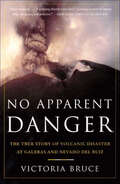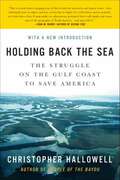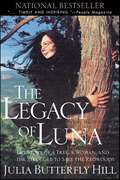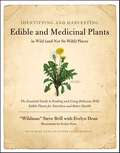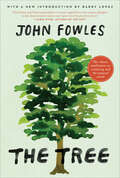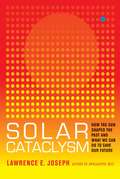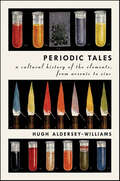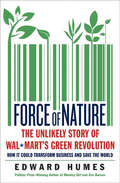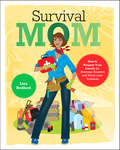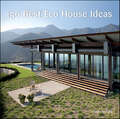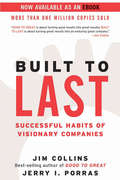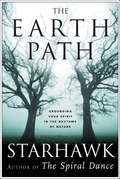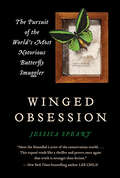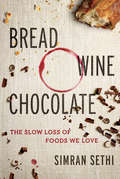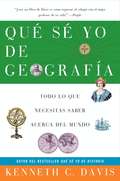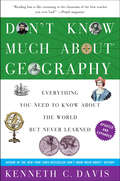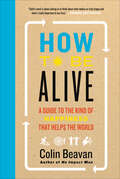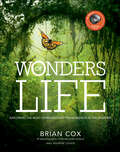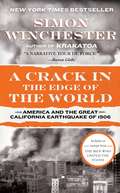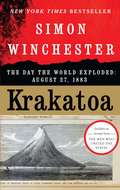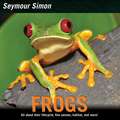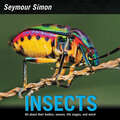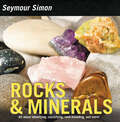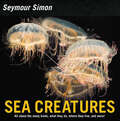- Table View
- List View
No Apparent Danger: The True Story of Volcanic Disaster at Galeras and Nevado Del Ruiz
by Victoria Bruce“Heart-stopping. . . . A gripping disaster story [and] a scathing account of human folly, arrogance and ambition.” –The New York Times Book ReviewOn January 14, 1993, a team of scientists descended into the crater of Galeras, an Andean volcano in Colombia, for a day of field research. As the group slowly moved toward the heart of the volcano, Galeras erupted. Nine men died instantly.Colombian geologist Marta Calvache raced into the rumbling crater, praying to find survivors. This was Calvache’s second volcanic disaster. In 1985 Calvache was part of a group of Colombia’s brightest young scientists that had been studying Nevado del Ruiz, a volcano three hundred miles north of Galeras. When Nevado del Ruiz erupted suddenly in November 1985, it killed more than twenty-three thousand people—one of the worst natural disasters of the twentieth century.In the aftermath of Nevado del Ruiz, volcanologists from all over the world came to Galeras to better understand the behavior of monumental forces at work deep within the earth. And yet, despite such expertise, fifteen people descended into a death trap at Galeras. Victoria Bruce weaves together the stories of the heroes, victims, survivors, and bystanders, evoking with great sensitivity what it means to live in the shadow of a volcano, and shows how clashing cultures and scientific arrogance resulted in tragedy. “Spellbinding.” —Publishers Weekly“A scientific thriller [that] shows how natural disasters are also the work of men.” —Boston Globe“A vivid account.” —Time Magazine“Impossible to put down.” —Sebastian Junger, #1 New York Times–bestselling author of The Perfect Storm
Holding Back the Sea: The Struggle on the Gulf Coast to Save America
by Christopher HallowellKatrina's arrival on the Gulf Coast was a long time in coming. But it was assured. Since 1965, when Hurricane Betsy struck New Orleans, breached a levee, and flooded part of the city, everyone was waiting and talking about when the Big One would strike and do even more damage. Katrina was that hurricane, predictedand imagined before she struck, but so much worse in her reality.Holding Back the Sea is about the consequences of ignoring the warning signs that nature provides and the struggle to convince the rest of the country that South Louisiana lay in the path of destruction. The signs were not subtle; there were Hurricanes Andrew in 1992, George and Mitch in 1998, and Ivan in 2004, among others. At one time or another in their journeys north, they all threatened New Orleans. Some had headed right for the city before veering to the east and west, sparing the Big Easy and reinforcing the nickname. But the Big Easy ended -- at least in reputation -- on August 29, 2005, when the Big One came ashore as Katrina.
Legacy of Luna: The Story of a Tree, a Woman, and the Struggle to Save the Redwoods
by Julia Butterfly HillOn December 18, 1999, Julia Butterfly Hill's feet touched the ground for the first time in over two years, as she descended from "Luna," a thousandyear-old redwood in Humboldt County, California.Hill had climbed 180 feet up into the tree high on a mountain on December 10, 1997, for what she thought would be a two- to three-week-long "tree-sit." The action was intended to stop Pacific Lumber, a division of the Maxxam Corporation, from the environmentally destructive process of clear-cutting the ancient redwood and the trees around it. The area immediately next to Luna had already been stripped and, because, as many believed, nothing was left to hold the soil to the mountain, a huge part of the hill had slid into the town of Stafford, wiping out many homes.Over the course of what turned into an historic civil action, Hill endured El Nino storms, helicopter harassment, a ten-day siege by company security guards, and the tremendous sorrow brought about by an old-growth forest's destruction. This story--written while she lived on a tiny platform eighteen stories off the ground--is one that only she can tell.Twenty-five-year-old Julia Butterfly Hill never planned to become what some have called her--the Rosa Parks of the environmental movement. Shenever expected to be honored as one of Good Housekeeping's "Most Admired Women of 1998" and George magazine's "20 Most Interesting Women in Politics," to be featured in People magazine's "25 Most Intriguing People of the Year" issue, or to receive hundreds of letters weekly from young people around the world. Indeed, when she first climbed into Luna, she had no way of knowing the harrowing weather conditions and the attacks on her and her cause. She had no idea of the loneliness she would face or that her feet wouldn't touch ground for more than two years. She couldn't predict the pain of being an eyewitness to the attempted destruction of one of the last ancient redwood forests in the world, nor could she anticipate the immeasurable strength she would gain or the life lessons she would learn from Luna. Although her brave vigil and indomitable spirit have made her a heroine in the eyes of many, Julia's story is a simple, heartening tale of love, conviction, and the profound courage she has summoned to fight for our earth's legacy.
Identifying & Harvesting Edible and Medicinal Plants (And Not So Wild Places): The Essential Guide to Finding and Using Delicious Wild Edible Plants for Nutrition and Better Health
by Steve Brill Evelyn DeanIdentifying and Harvesting Edible and Medicinal Plants in Wild (and Not So Wild) Places shows readers how to find and prepare more than five hundred different plants for nutrition and better health. It includes information on common plants such as mullein (a tea made from the leaves and flowers suppresses a cough), stinging nettle (steam the leaves and you have a tasty dish rich in iron), cattail (cooked stalks taste similar to corn and are rich in protein), and wild apricots (an infusion made with the leaves is good for stomach aches and digestive disorders). More than 260 detailed line drawings help readers identify a wide range of plants -- many of which are suited for cooking by following the more than thirty recipes included in this book. There are literally hundreds of plants readily available underfoot waiting to be harvested and used either as food or as a potential therapeutic. This book is both a field guide to nature's bounty and a source of intriguing information about the plants that surround us.
The Tree: John Fowles
by John FowlesThe classic meditation on creativity and the natural world“For years I have carried this book. . . with me on travels to reread, ponder, envy. In prose of classic gravity, precision, and delicacy, Fowles addresses matters of final importance.” —W. S. Merwin, Los Angeles Times Book Review“The Tree is the fullest and finest exploration I’ve ever read of how the useless delights to be discovered in nature can ripen into the practice of art.” —Lewis Hyde, author of The GiftFirst published a generation ago, The Tree is renowned English novelist John Fowles's provocative meditation on the connection between the natural world and human creativity, and a powerful argument against taming the wild. In it, Fowles recounts his own childhood in England and describes how he rebelled against his Edwardian father’s obsession with the “quantifiable yield” of well-pruned fruit trees and came to prize instead the messy, purposeless beauty of nature left to its wildest.The Tree is an inspiring, even life-changing book, one that reaffirms our connection to nature and reminds us of the pleasure of getting lost, the merits of having no plan, and the wisdom of following one’s nose wherever it may lead—in life as much as in art.This special 30th anniversary edition includes an introduction by Barry Lopez.
Solar Cataclysm: How the Sun Shaped the Past and What We Can Do to Save Our Future
by Lawrence E. JosephScience journalist and futurist Lawrence Joseph has studied the unprecedented solar storms since the last ice age and in Solar Cataclysm he reveals the monumental ecological, biological, emotional, political, financial, and cultural effects they have had in the past, and will ultimately have on humanity’s future. This timely, fascinating, and relevant book from the bestselling author of Apocalypse 2012 sounds an intelligent and urgent warning about the possible catastrophic consequences we will face in the coming years if we don’t listen to what the sun is trying to tell us. Popular science fans who made The World Without Us a runaway bestseller, readers open to new angles on history like those presented in Guns, Germs, and Steel, and anyone who is concerned about tomorrow and what we can do to ensure humankind’s survival must read Solar Cataclysm.
Periodic Tales: A Cultural History of the Elements, from Arsenic to Zinc
by Hugh Aldersey-WilliamsIn the spirit of A Short History of Nearly Everything comes Periodic Tales. Award-winning science writer Hugh Andersey-Williams offers readers a captivating look at the elements—and the amazing, little-known stories behind their discoveries. Periodic Tales is an energetic and wide-ranging book of innovations and innovators, of superstition and science and the myriad ways the chemical elements are woven into our culture, history, and language. It will delight readers of Genome, Einstein’s Dreams, Longitude, and The Age of Wonder.
Force of NatureThe Unlikely Story of WalMart's Green Revolution: The Unlikely Story of Wal-Mart's Green Revolution
by Edward HumesWhat happens when a renowned river guide teams up with the CEO of one of the largest and least Earth-friendly corporations in the world? When it's former Wal-Mart CEO H. Lee Scott and white-water expert turned sustainability consultant Jib Ellison, the result is nothing less than a green business revolution. Wal-Mart-long the target of local businesses, labor advocates, and environmentalists who deplore its outsourced, big-box methods-has embraced an unprecedented green makeover, which is now spreading worldwide. The retail giant that rose from Sam Walton's Ozarks dime store is leveraging the power of 200 million weekly customers to drive waste, toxics, and carbon emissions out of its stores and products. Neither an act of charity nor an empty greenwash, Wal-Mart's green move reflects its river guide's simple, compelling philosophy: that the most sustainable, clean, energy-efficient, and waste-free company will beat its competitors every time. Not just in some distant, utopian future but today. From energy conservation, recycling, and hybrid trucks to reduced packaging and partnerships with environmentalists it once met only in court, Wal-Mart has used sustainability to boost its bottom line even in a tough economy-belying the age-old claim that going green kills jobs and profits. Now the global apparel business, the American dairy industry, big agriculture, and even Wall Street are following Wal-Mart's lead, along with the 100,000 manufacturers whose products must become more sustainable to remain on Wal-Mart's shelves. Here Pulitzer Prize winner and bestselling author Edward Humes charts the course of this unlikely second industrial revolution, in which corporate titans who once believed profit and planet must be at odds are learning that the best business just may be a force of nature.
Survival Mom: How to Prepare Your Family for Everyday Disasters and Worst-Case Scenarios
by Lisa BedfordFrom the creator of TheSurvivalMom.com comes this first-of-its-kind guidebook for all the “prepper” moms keen to increase their family's level of preparedness for emergencies and crises of all shapes and sizes. Publisher’s Weekly calls Lisa Bedford’s Survival Mom an “impressively comprehensive manual,” saying, “suburban mom Bedford helps readers learn about, prepare for, and respond to all manner of disasters. . . . From 'Instant Survival Tip' sidebars to a list of 'Lessons from the Great Depression'. . . Bedford's matter-of-fact yet supportive tone will keep the willies at bay.”
150 Best Eco House Ideas
by Marta SerratsFeaturing an extensive collection of full-color photographs, 150 Best Eco House Ideas features eco-friendly house designs created by internationally renowned architects and designers who have achieved practical, innovative, and stunning solutions adapted to the specific needs and tastes of their clients. Included here are the latest innovations in sustainable home design, including solar paneling, wind energy systems, environmentally-friendly heating and cooling solutions, thermal glazing, and trombe walls.150 Best Eco House Ideas covering the diversity of current trends in sustainable home design, and is both the perfect resource for designers, interior decorators, and architects, as well an inspirational sourcebook for all homeowners interested in creating warm and inviting homes that cause only a fraction of the environmental impact of those created using conventional building methods.
Built to Last: Successful Habits of Visionary Companies (Good to Great #2)
by Jerry I. Porras Jim Collins"This is not a book about charismatic visionary leaders. It is not about visionary product concepts or visionary products or visionary market insights. Nor is it about just having a corporate vision. This is a book about something far more important, enduring, and substantial. This is a book about visionary companies." So write Jim Collins and Jerry Porras in this groundbreaking book that shatters myths, provides new insights, and gives practical guidance to those who would like to build landmark companies that stand the test of time.Drawing upon a six-year research project at the Stanford University Graduate School of Business, Collins and Porras took eighteen truly exceptional and long-lasting companies -- they have an average age of nearly one hundred years and have outperformed the general stock market by a factor of fifteen since 1926 -- and studied each company in direct comparison to one of its top competitors. They examined the companies from their very beginnings to the present day -- as start-ups, as midsize companies, and as large corporations. Throughout, the authors asked: "What makes the truly exceptional companies different from other companies?"What separates General Electric, 3M, Merck, Wal-Mart, Hewlett-Packard, Walt Disney, and Philip Morris from their rivals? How, for example, did Procter & Gamble, which began life substantially behind rival Colgate, eventually prevail as the premier institution in its industry? How was Motorola able to move from a humble battery repair business into integrated circuits and cellular communications, while Zenith never became dominant in anything other than TVs? How did Boeing unseat McDonnell Douglas as the world's best commercial aircraft company -- what did Boeing have that McDonnell Douglas lacked?By answering such questions, Collins and Porras go beyond the incessant barrage of management buzzwords and fads of the day to discover timeless qualities that have consistently distinguished out-standing companies. They also provide inspiration to all executives and entrepreneurs by destroying the false but widely accepted idea that only charismatic visionary leaders can build visionary companies.Filled with hundreds of specific examples and organized into a coherent framework of practical concepts that can be applied by managers and entrepreneurs at all levels, Built to Last provides a master blueprint for building organizations that will prosper long into the twenty-first century and beyond.
The Earth Path: Grounding Your Spirit in the Rhythms of Nature
by StarhawkThe bestselling author uses Wiccan sacred texts to show how we can have a more intimate connection with our surroundings.From time immemorial, artists and poets, prophets, and shamans have drawn strength and inspiration from walking the earth. In The Earth Path, bestselling author Starhawk takes the reader on a journey into the heart of the natural world, showing how we can have a more intimate connection with the world that surrounds us.Institutionalized religions have sacred texts—messages written in holy books that are the inspiration for their beliefs and rituals. But the sacred texts for Wicca, like other ancient native or indigenous traditions, are written in nature—in the magic circle of the elements: air, fire, water, and earth. With The Earth Path, Starhawk, an activist, ecofeminist, and leader in the women’s spirituality movement, places you in the center of that magical circle. As you become attuned to the rhythms of the earth, your thinking will shift from focusing on isolated objects to marveling at the multitude of interconnecting patterns and relationships in nature. These patterns and connections can hold the key to your own spiritual renewal and restore your sense of responsibility for preserving this world that nurtures and sustains us.Filled with awareness exercises, inspiring meditations, and magical rituals, The Earth Path not only teaches the reader to respect the ecology of our natural world, but shows how to spiritually connect with and channel the powers inherent in nature.Praise for The Earth Path“Starhawk presents an array of exercises and practices for sharpening observation and listening skills. She engages readers’ spirits and minds through her illustrative storytelling, offering ways to communicate more fully with the world and suggesting ways to act.” —Publishers Weekly“Lucid, appealing . . . a broad philosophy of harmony with nature, of human concord, sexual liberation, creativity, and healthy pleasure, as expressed and celebrated in a freewheeling worship of the universe.” —Kirkus Reviews
What Happens to Our Trash? (Let's-Read-and-Find-Out Science 2)
by D. J. WardRead and find out about how we can reduce, reuse, and recycle in this colorfully illustrated nonfiction picture book."Perfect for classes just beginning to study environmental concerns," wrote School Library Journal. "Engaging prose and upbeat, gently humorous illustrations introduce the importance of proper trash disposal and recycling."This is a clear and appealing science book for early elementary age kids, both at home and in the classroom. In clear language and art, including diagrams, the book takes readers through such details as how much trash each person creates every day (on average), where the trash goes, and ways kids can make a difference. It concludes with instructions on how to create a compost pileWhat Happens to Our Trash is a Level 2 Let's-Read-and-Find-Out, which means the book explores more challenging concepts for children in the primary grades. The 100+ titles in this leading nonfiction series are:hands-on and visualacclaimed and trustedgreat for classroomsTop 10 reasons to love LRFOs:Entertain and educate at the same timeHave appealing, child-centered topicsDevelopmentally appropriate for emerging readersFocused; answering questions instead of using survey approachEmploy engaging picture book quality illustrationsUse simple charts and graphics to improve visual literacy skillsFeature hands-on activities to engage young scientistsMeet national science education standardsWritten/illustrated by award-winning authors/illustrators & vetted by an expert in the fieldOver 130 titles in print, meeting a wide range of kids' scientific interestsBooks in this series support the Common Core Learning Standards, Next Generation Science Standards, and the Science, Technology, Engineering, and Math (STEM) standards. Let's-Read-and-Find-Out is the winner of the American Association for the Advancement of Science/Subaru Science Books & Films Prize for Outstanding Science Series.
Winged Obsession: The Pursuit of the World's Most Notorious Butterfly Smuggler
by Jessica SpeartOne of the world's most beautiful endangered species, butterflies are as lucrative as gorillas, pandas, and rhinos on the black market. In this cutthroat $200 million business, no one was more successful—or posed a greater ecological danger—than Yoshi Kojima, the kingpin of butterfly smugglers.In Winged Obsession, author Jessica Speart tells the riveting true story of rookie U.S. Fish and Wildlife Agent Ed Newcomer's determined crusade to halt the career of a brazen and ingenious criminal with an almost supernatural sixth sense for survival. But the story doesn't end there. Speart chronicles her own attempts, while researching the book, to befriend Kojima before betraying him—unaware that the cagey smuggler had his own plans to make the writer a player in his illegal butterfly trade.
Bread, Wine, Chocolate: The Slow Loss of Foods We Love
by Simran SethiAward-winning journalist Simran Sethi explores the history and cultural importance of our most beloved tastes, paying homage to the ingredients that give us daily pleasure, while providing a thoughtful wake-up call to the homogenization that is threatening the diversity of our food supply.Food is one of the greatest pleasures of human life. Our response to sweet, salty, bitter, or sour is deeply personal, combining our individual biological characteristics, personal preferences, and emotional connections. Bread, Wine, Chocolate illuminates not only what it means to recognize the importance of the foods we love, but also what it means to lose them. Award-winning journalist Simran Sethi reveals how the foods we enjoy are endangered by genetic erosion—a slow and steady loss of diversity in what we grow and eat. In America today, food often looks and tastes the same, whether at a San Francisco farmers market or at a Midwestern potluck. Shockingly, 95% of the world’s calories now come from only thirty species. Though supermarkets seem to be stocked with endless options, the differences between products are superficial, primarily in flavor and brand.Sethi draws on interviews with scientists, farmers, chefs, vintners, beer brewers, coffee roasters and others with firsthand knowledge of our food to reveal the multiple and interconnected reasons for this loss, and its consequences for our health, traditions, and culture. She travels to Ethiopian coffee forests, British yeast culture labs, and Ecuadoran cocoa plantations collecting fascinating stories that will inspire readers to eat more consciously and purposefully, better understand familiar and new foods, and learn what it takes to save the tastes that connect us with the world around us.
Que Se Yo de Geografia
by Kenneth C. DavisAcompáñanos mientras Kenneth C. Davis, autor del bestseller Qué Sé Yo de Historia, nos lleva en un fascinante, asombroso y divertidísimo tour del planeta Tierra -- una excursión que nos abrirá los ojos y la imaginación a un extenso, salvaje y sorprendente mundo que no conocíamos.
Don't Know Much About Geography: Everything You Need to Know About the World but Never Learned (The Don't Know Much About Series)
by Kenneth C. DavisAn “entertaining [and] eminently readable” exploration of our home planet from the New York Times–bestselling author of Don’t Know Much About History(Publishers Weekly).Geography is much more than naming countries on a map or memorizing state capitals. It’s the hub from which other disciplines radiate: meteorology, ecology, geology, oceanography, demographics, cartography, agricultural studies, economics, and political science. Yet many of us don’t know much about it. This fun and fascinating guide can change that!In addition to presenting plenty of geographical trivia to impress your friends, Kenneth C. Davis explores 21st-century topics of global concern, including the role of the Internet and technology in transforming the lives of people around the world, how so-called developing nations develop, sustainability, and debates over climate change and evolutionary science. This completely revised and updated version of Don't Know Much About Geography is an illuminating grand tour of planet Earth.“Reading [Kenneth C. Davis] is like returning to the classroom of the best teacher you ever had.” —PeopleA School Library Journal “Must-Read”
How to Be Alive: A Guide to the Kind of Happiness That Helps the World
by Colin Beavan“This is the book where self-help turns into helping the world—and then turns back into helping yourself find a better life. Fascinating and timely!”—Bill McKibben, author of Eaarth: Making a Life on a Tough New PlanetWhat does it take to achieve a successful and satisfying life? Not long ago, the answer seemed as simple as following a straightforward path: college, career, house, marriage, kids, and a secure retirement. Not anymore. Staggering student loan debt, sweeping job shortages, a chronically ailing economy—plus the larger issues of global unrest, poverty, and our imperiled environment—make the search for fulfillment more challenging. And, as Colin Beavan, activist and author of No Impact Man, proclaims, more exciting.In this breakthrough book, Beavan extends a hand to those seeking more meaning and joy in life even as they engage in addressing our various world crises. How to Be Alive nudges the unfulfilled toward creating their own version of the Good Life—a life where feeling good and doing good intersect. He urges readers to reexamine the “standard life approaches” to pretty much everything and to experiment with life choices that are truer to their values, passions, and concerns.How do you stop placing limits on your potential impact? How do you make your choices really matter in everything from your clothing purchases to your career? How do you find the people who will most support you in your quest for a good life? To answer these questions and more, Beavan draws on classic literature and philosophy; surprising new scientific findings; and the uplifting personal stories of real-life “lifequesters”—people who are breaking away from those old broken paths, blazing fresh trails, and reveling in every step along the way.“There is a movement afoot for a better life and Colin Beavan is its prophet, with a new book as powerful as his already classic No Impact Man.”—John de Graaf, coauthor of Affluenza
Wonders of Life: Exploring the Most Extraordinary Phenomenon in the Universe (Wonders Series)
by Andrew Cohen Brian CoxIn Wonders of Life: Exploring the Most Extraordinary Force in the Universe, the definitive companion to the Discovery Science Channel series, Professor Brian Cox takes us on an incredible journey to discover the most complex, diverse, and unique force in the universe: life itself.Through his voyage of discovery, international bestselling author Brian Cox explains how the astonishing inventiveness of nature came about and uncovers the milestones in the epic journey from the origin of life to our own lives, with beautiful full-color illustrations throughout. From spectacular fountains of superheated water at the bottom of the Atlantic to the deepest rainforest, Cox seeks out the places where the biggest questions about life may be answered: What is life? Why do we need water? Why does life end?Physicist and professor Brian Cox uncovers the secrets of life in the most unexpected locations and in the most stunning detail in this beautiful full-color volume.
A Crack in the Edge of the World: America and the Great California Earthquake of 1906
by Simon WinchesterA burgeoning new city is built on the dreams of the American gold rush. It is also built upon a landscape that has been stretching, sliding and breaking apart for millennia. In 1906 the dreams of this city came crashing down beneath the rippling wave of a horrifying earthquake that turned roads into great rippling rivers, that set buildings ablaze for days on end, that made homes collapse upon themselves. Simon Winchester's breathtaking story delves deep beneath the surface of the earth and explains to us why the world moves as it does; and breaks apart with such devastating results. At the same time he never lets us forget the human story: what happened in this new, seemingly blessed city on the 18th April 1906. As he vividly portrays the lives of the people who suffered and survived the devastation he also tells a universal story: the hubris of man as he ignores the warnings of nature and how we respond and try to understand the world around us. Compelling, moving and enlightening, Simon Winchester brings to light the world beneath our feet and through the story of this one terrifying event one hundred years ago, begins to make sense of our world now.
Krakatoa: The Day the World Exploded: August 27, 1883
by Simon WinchesterThe bestselling author of The Professor and the Madman and The Map That Changed the World examines the enduring and world-changing effects of the catastrophic eruption off the coast of Java of the earth's most dangerous volcano -- Krakatoa.The legendary annihilation in 1883 of the volcano-island of Krakatoa -- the name has since become a byword for a cataclysmic disaster -- was followed by an immense tsunami that killed nearly forty thousand people. Beyond the purely physical horrors of an event that has only very recently been properly understood, the eruption changed the world in more ways than could possibly be imagined. Dust swirled round die planet for years, causing temperatures to plummet and sunsets to turn vivid with lurid and unsettling displays of light. The effects of the immense waves were felt as far away as France. Barometers in Bogotá and Washington, D.C., went haywire. Bodies were washed up in Zanzibar. The sound of the island's destruction was heard in Australia and India and on islands thousands of miles away. Most significant of all -- in view of today's new political climate -- the eruption helped to trigger in Java a wave of murderous anti-Western militancy among fundamentalist Muslims: one of the first outbreaks of Islamic-inspired killings anywhere.Simon Winchester's long experience in the world wandering as well as his knowledge of history and geology give us an entirely new perspective on this fascinating and iconic event as he brings it telling back to life.
Frogs (Seymour Simon Science Ser.)
by Seymour SimonAward-winning science writer Seymour Simon takes readers on a journey through a frog's life cycle, from egg to tadpole to grown frog in this engaging nonfiction picture book. Readers will learn about the different types of frogs and toads from all over the world! Where do frogs live? How do frogs eat and drink? How far can they jump? Find out and more in this beautiful picture book ideal for young scientists and animal-lovers filled with fascinating facts, stunning full-color photographs, and an underlying message of ecological preservation.. This book includes an author's note, a glossary, and an index. An excellent choice for classrooms and homeschooling, Frogs supports the Common Core State Standards.
Insects (Seymour Simon Science Ser.)
by Seymour SimonAward-winning science writer Seymour Simon explores the wonderful world of insects, with fascinating facts and stunning full-color photographs, in his latest nonfiction picture book. Readers will learn all about insects’ life stages, senses, bodies, and the many different kinds, including beetles, ladybugs, bees, butterflies, and more! This nonfiction picture book is an excellent choice to share during homeschooling, in particular for children ages 6 to 8. It’s a fun way to learn to read and as a supplement for activity books for children.This updated edition includes:Stunning full-color photographsGlossaryIndexWebsite and additional reading sourcesSupports the Common Core Learning Standards, Next Generation Science Standards, and the Science, Technology, Engineering, and Math (STEM) standards
Rocks & Minerals
by Seymour SimonAward-winning science writer Seymour Simon explains to readers the different types of rocks and minerals with fascinating facts and stunning full-color photographs. This nonfiction picture book is an excellent choice to share during homeschooling, in particular for children ages 6 to 8. It’s a fun way to learn to read and as a supplement for activity books for children.Readers will learn how to identify and classify various kinds of stones, such as granite, sandstone, basalt, quartz, and crystal.This book includes an author's note, a glossary, and an index and supports the Common Core State Standards.
Sea Creatures
by Seymour SimonDive into the wonderful world under the sea with Sea Creatures, a gorgeous informational picture book from award-winning science writer Seymour Simon! This nonfiction picture book is an excellent choice to share during homeschooling, in particular for children ages 6 to 8. It’s a fun way to learn to read and as a supplement for activity books for children.Ranging from tiny single-celled creatures to the larger-than-life whales, the ocean is filled with life. Some sea animals live in the darkest depths of the ocean, while others live close to sunlight. From camouflage to way of communicating to existing symbiotically, sea creatures are some of the most adaptable animals on Earth. With clear, simple text and stunning full-color photographs, readers will explore the deep blue sea and meet all types of aquatic friends.This book includes an author's note, a glossary, and an index and supports the Common Core State Standards.
